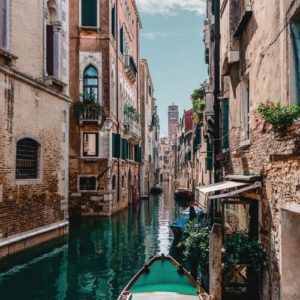Venetian Sounds
Description
The soundtracks presented here are part of ongoing fieldwork that I am carrying out in Venice and the surrounding lagoon. The sounds are selected according to their cultural significance and close relationship to the ecological environment, their character of signs, whose meanings are specific, shared by the community or related to some specific activities, their power to express a sense of belonging for a local population (around 55.000 people) immersed in the everyday presence of visitors ( around 25 millions per year) and the local language spoken in public gatherings as a sign of shared identity.
Venice is one of the most visually represented and photographically recorded places in the world. Millions of tourists take home images of what they have seen in instant eye-shots and stored in their digital devices. But the unique nature of a city with no streets, no cars, no usual urban sounds is hardly noticed.
An interesting contrast is offered by the significance given to sonic messages by the Venetians, not only as the ever-reinforced cultural meaning of a socially shared belonging – typically represented by the lively use of the local language – but also as specific,often cryptic codes, such as Hoe!, the voice heard breaking the silent recording of track 2. This same Hoe! was heard by John Ruskin, as reported in The Stones of Venice two hundred years ago. In track 3, at an astonishingly short distance from the Babel of languages that is the tourist crowd, you can listen to the pure Venetian sounds of conversation when people are meeting strolling or shopping. Then you feel like being in a Goldoni play. Even who don’t understand the words can feel the mood by the expressive rhythm, the masculine and feminine tones, the humour, the sense of pleasure when meeting the passers-by.
Listening
Track 1
MARANGONA BELL AT MIDNIGHT captures the sound of the biggest bell (diameter. 1.8 m tonality La-A) atop of St. Mark’s tower, that sounds alone every midnight. At the time of the Republic of Venice, this bell was used to mark the working hours of the marangoni, the carpenters at the nearby arsenal and by association the whole city it was given an ironic nickname: el paròn de cà, meaning ‘the landlord’. The composer Luigi Nono used to say that he could hear the deep sound of the Marangona transmitted through the vibrations in the water of the lagoon,reaching him on Giudecca island, where he lived;
Track 2
ROWING IN THE CANALS captures the sound of silence that some Venetians still try to feel rowing in a light, flat-keeled sàndolo at dawn, before the city wakes up. At the narrow corners of the canal, Hoe! is the code to warn possible incoming boats coming from the opposite side;
Track 3
VIA GARIBALDI was registered in the only Via (Street) in Venice. It is the centre of the Sestiere Castello (one of the six boroughs into which Venice is divided). Traditionally the working class area of the city, far from the splendors of the Grand Canal. It is here where one might say that the Venetian soul is best preserved.
Equipment
Zoom H4n
Biography
Antonio Marazzi. Past Professor of Cultural Anthropology, University of Padova, and former Chairman of the IUAES Commission on Visual Anthropology. At the IUAES Inter-Congress in Ottawa (2017) he organized a panel on Aural Anthropology.
He is author of the book Antropologia dei sensi (Carocci 2010, in Italian).
